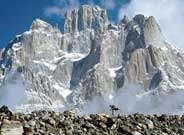
|
 |
Mail Magazine 24...
Glaciers on Asia’s
largest mountain range getting BIGGER
by Robert Felix
Satellite data shows that glaciers in part of the Karakoram range on
the China-Pakistan border are putting on mass, defying (supposedly) the
general trend toward glacier shrinkage.
In an article entitled “Slight mass gain of Karakoram glaciers in the
early twenty-first century,” Researchers from the National Centre for
Scientific Research and the University of Grenoble admit to “an
anomalous gain of mass” for the Karakoram glaciers.
This is in direct contradiction to the 2007 Intergovernmental Panel on
Climate Change (IPCC) report, which claimed that ice from most of the
region could disappear by 2035. (See
world-misled-over-melting-himalayan-glaciers/ )
Often considered a part of the Himalayas, the Karakoram range, which
runs through Pakistan, India and China, is technically a separate chain
that includes K2, the world’s second-highest peak.
Although there were wide variations between individual glaciers, the
mass of the glaciers in this 2,168-square-mile (5,615-sq-km) area
increased marginally. “Our measurements…indicate that the contribution
of Karakoram glaciers to sea-level rise was -0.01 mm yr for the period
from 1999 to 2008,” write the French researchers.
Huh? What does that mean? “The contribution to sea-level rise was MINUS
0.01 mm per year”? Sounds like Orwellian double-speak to me.
“Why this (the increase) should be is not clear,” writes BBC News
environment correspondent Richard Black. “Though it is well known from
studies in other parts of the world that climate change can cause extra
precipitation into cold regions which, if they are cold enough, gets
added to the existing mass of ice.”
Uh huh. First we’re told that global warming will melt all of the
world’s glaciers and sea levels will rise catastrophically. Now, we’re
being told that global warming will make the glaciers grow and
contribute - in a minus sort of way - to sea level rise. Does that mean
that sea levels will fall?
“We don’t really know the reason,” said lead researcher Julie Gardelle.
“Right now we believe that it could be due to a very specific regional
climate over Karakoram because there have been meteorological
measurements showing increased winter precipitation; but that’s just a
guess at this stage.”
Meanwhile, correspondent Black tries to convince us that the majority
of Himalayan glaciers are growing. “Late last year,” says Black, “the
Kathmandu-based International Centre for Integrated Mountain
Development (Icimod) released data showing that across 10 regularly
studied glaciers, the rate of ice loss had doubled since the 1980s.”
“Ten regularly studied glaciers”? Make sure you caught that, because
Mr. Black then begrudgingly admits that “these 10 intensively studied
glaciers” are “among a total of more than 54,000.”
We’re spending billions upon billions of dollars to fight global
warming based on 10 melting glaciers? Ten? Out of a total of more than
54,000?
What is wrong with our leaders?
As a matter of fact, the Himalayas have lost no ice in the past ten
years. We’re talking about the greatest chain of ice-capped peaks in
the world—from the Himalayas to Tian Shan on the border of China and
Kyrgyzstan—and satellite measurements show that they have lost NO ice
in the past 10 years.
Not only have they lost no ice, in a defiant act of political
incorrectness, some 230 glaciers in the western Himalayas - including
Mount Everest, K2 and Nanga Parbat - are actually growing.
“These are the biggest mid-latitude glaciers in the world,” says John
Shroder of the University of Nebraska-Omaha. “And all of them are
either holding still, or advancing.”
And get this. Eighty seven of those glaciers have surged forward since
the 1960s.
But we don’t need to look to the Himalayas for growing glaciers.
Glaciers are also growing in the United States. Yes, in the United
States.
Look at California. All seven glaciers on California’s Mount Shasta are
growing, including three-mile-long Whitney glacier, the state’s
largest.
Farther north in Washington State, the Nisqually Glacier on Mt. Rainier
is growing. The Emmons Glacier on Mt. Rainier is growing. Glaciers on
Glacier Peak in northern Washington are growing. And Crater Glacier on
Mt. Saint Helens is now larger than it was before the 1980 eruption.
Even farther north, the Juneau Icefield, which covers 1,505 square
miles (3,900 sq km) and is the fifth-largest ice field in the Western
Hemisphere, is also growing.
Are these growing glaciers also just “an anomalous gain of mass”? Well,
let’s look at a few other countries.
Perito Moreno Glacier, the largest glacier in Argentina, is growing.
Pio XI Glacier, the largest glacier in Chile, is growing.
Glaciers are growing on Mt. Logan, the tallest mountain in Canada.
Glaciers are growing on Mt. Blanc, the tallest mountain in France.
Glaciers are growing in Norway, says the Norwegian Water Resources and
Energy Directorate (NVE).
And the last time I checked, all 50 glaciers in New Zealand were
growing. (The Franz Josef glacier is advancing at the rate of 4 to 7
feet per day!)
But these glaciers are babies when you look at our planet’s largest ice
mass, namely, the Antarctic ice sheet.
Contrary to what you may have heard, this huge ice sheet is growing.
In 2007, Antarctica set a new record for most ice extent since 1979,
says meteorologist Joe D’Aleo. Antarctic sea ice has also been
increasing, on average, since 1980.
Think about that.
The Antarctic Ice Sheet, which is almost twice as big as the contiguous
United States, is about 90 times bigger than all of the rest of the
world’s glaciers combined.
Close to 90 percent of the world’s glaciers are growing, in other
words, and all we hear about are the ones that are shrinking.
Welcome to the new ice age.
Source: canadafreepress.com
Read this and other articles at Mail Magazine 24
|
|
|
|

